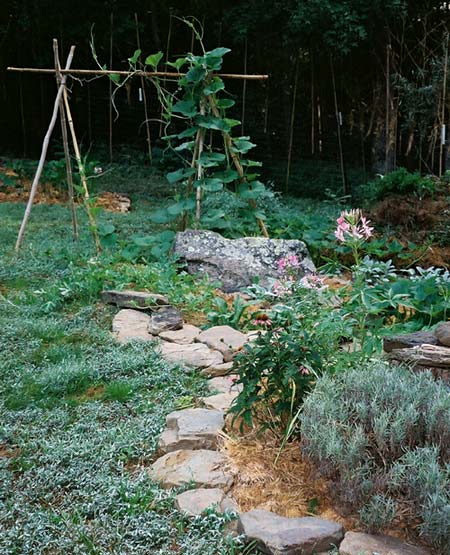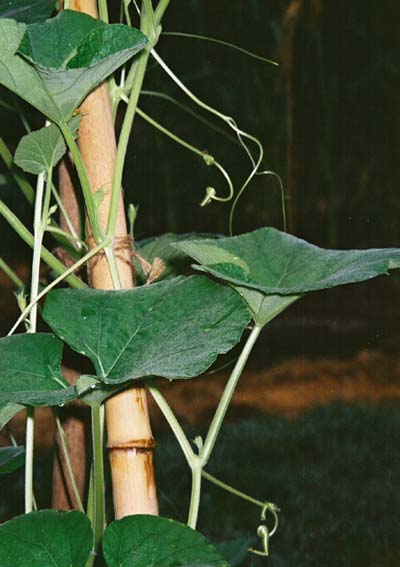
Clematis Among the Eastern White Pine Cones in Paula's Wreath
Spring finds every gardener full of enthusiasm for the turning of the seasons. We want to turn the soil of our gardens and work magic with Mother Nature. We are ready to turn our backs on winter and our faces toward the sun. We gather our seeds, tools and bring our grand hopes to our plantings. The new seedlings and spurts of growth spur us on to get up early and work long days in our grubby garden clothes. As the days get hotter and the insects arrive to torment us and our vegetative friends, we can falter in our efforts to weed, water and pick hornworms. Tim Stark put it this way, ” After twelve years of growing vegetables, I have learned to accept that every [growing] season presents a unique set of conditions that invariably prove to be less than optimal.” Stark wrote this in Heirloom: Notes from an Accidental Tomato Farmer. Wind, rain, no rain, bugs, heat, cold, and/or animal attacks can overwhelm the most enthusiastic gardener.
I try to look to my successes and minimize a focus on the non-successes. When I started quilting in 1994, my mentor Lila Rostenberg interrupted me when I tried to point out the mistakes in my current project. Lila assured me that there was no need to point out my mistakes. I took Lila’s advice seriously and always pass it on to my quilting students. I also appy it to my garden projects. When I am in my garden I employ the same strategy–it is a strategy you know! I learn what I can about the plants that do not thrive and I keep trying until it becomes clear that my garden is not meant to grow, for example, lovely delphiniums because they cannot tolerate our hot days and hot nights. I look for similar alternative plants. In the case of delphiniums, I found larkspur which do thrive here and even self-seed themselves for next year.
Today I’ve prepared a garden tour of some of our early-season successes starting in our main garden. At the center “grows” a driftwood figure we call our Dancing Goddess! The original was a piece of driftwood we discovered down the mountain along the river after a storm. It took a decade for the first Dancing Goddess to melt back into the earth. The current goddess is formed from part of the root system from an Osage Orange (also called Bodark or Hedge) tree we had to remove twenty years ago. Her outstretched arm holds this pinecone wreath I fashioned from the cones from the Eastern White Pine. I am fascinated by the curvy shapes of these cones. Not pictured, but below the Dancing Goddess, lounge bright red bee balm flowers to entice hummingbirds.

Striper Hunts Bugs Under the Tomatoes
Striper was a howling kitten when Jeanne found him abandoned down by the river. Named for his distinctive bold orange stripes he is posed below the thriving tomatoes. Each morning and evening, Striper also looks for bugs while I scan the tomato stems carefully for the camouflaged hornworms disguised as just another tomato stem. Below Stiper are the basil plants and to the right are sage plants spilling into the path.

Cleome or Spider Flowers Dot the Garden with Color by Mid-Summer
When we expanded our garden this spring I moved these purple coneflowers, the silver lamb’s ear and the cleome to our former visually neglected compost area. We needed the bed space for edibles. I landscaped with large rocks from the river to provide steps in this steep area. In the background you can see that Jeanne has created a huge mound of fresh materials to make fresh compost. The gold flowers are the first blooms of the rambling pumpkin patch. Some of the ten foot vines reached to the fence and the deer pulled on the vines through the fence to consume the tender growth.

Jeanne's Carefully Mounded Compost Pile in the Background with Huge Gourd leaves on the Far Left of the Picture
Our birdhouse gourd vines exhibited exuberant growth up the bamboo trellis I’ve provided. They seem to grow ten inches overnight and the long curling tendrils reach out for support and comfort (or so it seems,)when I walk by. Yesterday I found the first of the delicate white flowers that will transform themselves into foot long gourds in less thatn two months. These miracles of creation draw me back to the garden day after day. I depend on them to renew me. And I depend on these miracles to renew my commitment to hauling water and attending to the other needs of a successful garden–most of which I enjoy.
Gourds large and small were used by native peoples for serving dishes, mixing bowls, plates, dippers, storage and even for heating liquids. Once dried and cured gourds are strong and useful tools. To heat liquids in a gourd, one does not place the gourd over a hot fire. Instead, one heats several small clean rocks on the edge of a fire. Then using wood tongs the heated rocks are carefully dropped into the liquid transferring the heat from the rocks to the liquid.

Birdhouse Gourds in the Background and Lavender in the Foreground
Jeanne and I choose to add flowers and herbs to the mix in our vegetable garden. From comfrey and astragalus to foxgloves, coneflowers and morning glories we depend on these to bring pollinaters and to offer spots of color and texture to the garden canvas. This is our most ambitious garden; we are growing strawberries, corn, basil, garlic, cucumbers, yellow squash, carrots, pumpkins, watermelon, three varieties of tomatoes, gourds, several types of beans and a variety of greens. Last fall we planted three apple trees and cleared around a “found” mulberry tree.

Morning Glories Beginning to Climb the Obelisk
Our yellow crookneck squash are buzzing with bees and beginning to produce the tender squash as the flowers fade to fruit, or in this case vegetables. The leaves are over a foot across and erect like an umbrella. We are seeing unwelcome signs of powdery mildew on the leaves of the squash and the cucumbers. Both of these plants have prickly hairs that irritate the forearms as we pick underneath the leaves searching for young fruit before they become oversized. Some people have a severe reaction to this irritant. Beware.

Lush Growth on the Squash Plants with many Cleome in the Background
Our end-of-July garden tour of Cedar Hill closes with a closeup picture of the tendrils that tether these luxuriant birdhouse gourd vines to any nearby object. Each tendril has its own agenda as it stretches and twines toward a stationary object. The bamboo is harvested from our own homegrown stand. Our bamboo trellis lifts the vines off the ground and toward the sunlight allowing air to circulate among the leaves. Circulating air minimizes the chance of invasions of unfriendly mildew spores here in the garden as well as indoors if not using air conditioning.
If you look closely you will see that I have used jute to train the vines up the slippery bamboo poles. Gourds too have prickly leaves, but assisting the vines by tying them carefully to the bamboo is part of my ongoing relationship to the summer garden. Cool moist mornings are my favorite time of a day in the garden. The early morning promise is rather like the hopefulness of spring. Sustained commitment to nurturing and harvesting rewards you with snacks of perfect strawberries and tastes of green beans so tender when plucked off the bush that you do not dream of cooking them. Munch them whole while they last. It will be a long wait until next year’s crop.

Tethering Tendrils of the Birdhouse Gourds


Your garden is a delight…and lots of goodies to eat will be coming along!
I can testify to the skin-rash problems from some of those prickly vines and leaves!
Striper is such a good garden cat!
Comment by lila — July 27, 2009 @ 3:11 pm
Was checking the web to see if it’s ok to put gourd leaves and stems in the compost pile and your site came up. Gorgeous garden by the way. Many of my gourd leaves have mildew now and with the rains starting, it’s time to chop them but with the mildew, do you recommend adding them to the compost pile?
Comment by Mona Brauer — October 14, 2009 @ 11:20 am